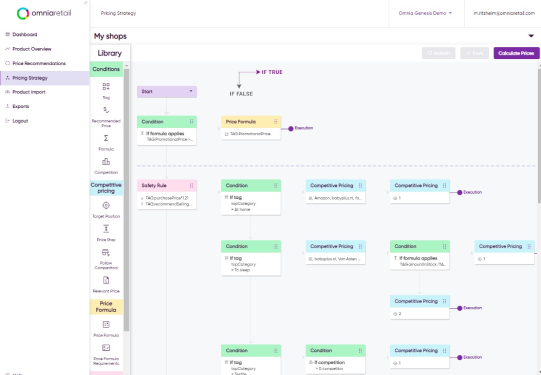Pricing on online marketplaces plays a vital role in e-commerce success. Online marketplaces now make up 62% of all online purchases. Retailers who sell on multiple platforms earn 190% more revenue than those selling on a single channel. These numbers show the massive potential of a smart marketplace strategy.
Setting the right prices across different marketplaces remains challenging. Amazon's marketplace illustrates this perfectly - 63% of its shoppers check prices before buying, while close to 2 million sellers compete for the Buy Box. A powerful marketplace pricing strategy matters more than ever. Different pricing on platforms like Amazon and eBay might help maximize your revenue.
This piece will guide you in building an analytical pricing framework, highlight key differences among various marketplaces, and provide tips for developing differentiated marketplace strategies. These practical approaches will help you understand why its important to optimize prices and maintain profitability on each platform.
Building Your Marketplace Pricing Strategy Framework
A marketplace pricing strategy requires a clear framework that aligns with each platform's unique ecosystem. Selling across platforms demands a more strategic approach than traditional retail. You need to consider varying customer expectations and operational costs.
Brands, retailers, and consumers all converge on these platforms, each with their own motivations and benefits. Brands and retailers leverage marketplaces to enhance visibility, boost profitability, and assess price competitiveness. Meanwhile, consumers are drawn to marketplaces for the convenience of comparing prices across multiple vendors without the hassle of navigating different websites.
How do marketplaces shape online pricing?
Marketplaces significantly influence pricing dynamics. The low entry barriers allow more competitors to join easily, reducing the need for extensive SEO and SEA efforts. This environment fosters dynamic pricing, where prices fluctuate based on various factors. Consumers benefit from increased transparency, not only in pricing but also in delivery and service options. Additionally, marketplaces introduce Buy Box dynamics, making pricing less static and more competitive.
What do we know about the pricing differences in marketplaces?
In an in-house research study, we analyzed data from the beauty, sports, and fashion industries across different marketplaces in Germany between January and December 2024, focusing only on non-promotional weeks. This comprehensive analysis allowed us to identify key trends and pricing behaviors unique to each marketplace. By examining these patterns, we can better understand how various factors, such as competition and consumer preferences, shape pricing strategies across the board.
Marketplace Pricing Differences
Marketplace pricing is not one-size-fits-all
- Different levels of competition and fee structures influence pricing per platform.
- Some marketplaces encourage low pricing, while others allow premium positioning.
Most vendors adjust prices per platform
- 61.1% of vendors use a differentiated pricing strategy tailored to marketplace dynamics.
- No single marketplace consistently offers the lowest price, making pricing decisions complex.
Price trends reveal strategic opportunities
- Amazon maintains stable pricing.
- eBay shows higher price volatility.
- Kaufland positions itself with consistently higher prices.
Pricing strategies vary significantly per marketplace
Some platforms have more competition encouraging low pricing, while other maintain different fees leading to higher pricing.
Amazon tends to have lower prices than eBay, indicating a more competitive landscape.
In comparison to Kaufland we would see lower pricing, indicting a difference in fees.
Understanding price trends across marketplaces helps identify competitive differences and strategic opportunities. While Amazon maintains stable pricing, eBay shows volatility, and Kaufland positions itself with consistently higher prices.
Amazon.de: Stable Pricing - Likely automated repricing, fewer fluctuations
eBay.de: More volatile, declining prices - Price-sensitive sellers, heavy competition
Kaufland.de: highest and most stable prices - Less discounting, possibly premium positioning
Understanding your competition in different marketplace
You need to know your competition in marketplaces to position your products well.
Each platform draws different customer groups with unique price sensitivities. Amazon shoppers compare prices 63% of the time before buying, which makes competitive pricing vital. Software like Omnia help you track competitors' pricing patterns and learn about market trends to make smart decisions.
Creating clear pricing strategies for each marketplace
Your marketplace pricing framework needs specific goals translated into pricing strategies. These goals should line up with your bigger business plans, whether you want to maximize quick profits through price skimming or gain long-term market share through penetration pricing.
Your pricing goals might change between platforms. Amazon's fierce Buy Box competition might make competitive pricing your top priority. eBay lets you retain control over customer relationships and branding, so you might focus on higher margins or customer loyalty.
Smart and dynamic pricing strategies will keep your business profitable long-term. They help maintain your market position and build customer loyalty.
Data-Driven Decision Making for Cross-Platform Pricing
Companies that use data based analysis to set their marketplace prices make better decisions. Research shows data-driven organizations are 19 times more likely to remain profitable. Highquality data, such as provided by Omnia, plays a crucial role to optimize your cross-platform pricing strategy.
Analyzing current marketplace data in Omnia
Omnia’s offering includes price monitoring across multiple domains, featuring a user-friendly interface that encourages collaboration on various market strategies, including international ones. An all-in-one solution is essential for optimizing and implementing automated pricing strategies across platforms in the long term.
Here are some questions that Omnia can help you answer:
- Which marketplace has the highest number of listings for different categories?
- Are your main competitors more active in one domain than others?
- Which marketplace has the most offers below your selling price?
- Which marketplace shows the largest average price difference compared to your selling price?
- Which marketplace has the least price variation?
How can Omnia help?
- Wide array of marketplaces data source to choose from in different countries
- Options to choose the different data points from directly scraped marketplaces. Eg: bol sold by bol or cheapest on bol.
- Competitor selections in the pricing tree based on the different marketplaces
- Blacklist and whitelist different data points from marketplaces from price calculations
- Timing your price changes for maximum effect - With Omnia, get pricing data whenever you wish and automatically update your prices.
Unlock smarter marketplace pricing & schedule a pricing insights session.
/Price%20Recommendations%20by%20Omnia%20Retail_v2.png)
Measuring Success and Optimizing Your Pricing Strategy
Successful marketplace pricing needs regular evaluation and updates. Companies that rely on analytics are 6% more profitable than their competitors. Measurement plays a vital role in your cross-platform pricing strategy.
Key performance indicators for cross-platform pricing
The right metrics help you make better pricing decisions across marketplaces. These are the vital KPIs to track:
You should watch how price changes affect each metric. Regular monitoring helps you spot trends and adjust your marketplace pricing strategy as needed.
Understanding how market conditions and the prices of your competitors impact sales is crucial. With Omnia’s insight, you will be able to better assess the influence of factors like competitor pricing on your product’s performance.
Long-term vs. short-term pricing considerations
Smart pricing balances quick wins with sustainable growth. Short-term pricing aims for fast gains through promotions or temporary discounts. Long-term strategies focus on customer loyalty and steady revenue.
Many new sellers focus only on revenue, but this approach can mislead. Pricing Expert Prof. Hermann Simon, puts it well: “Profit orientation is the only meaningful goal because it is the only one that observes both the market side and the cost side”. The priority should be profit margins that keep operations running smoothly.
Setting competitive prices while maintaining profits is vital for lasting success. Your pricing strategy must evolve with market conditions, seasons, and other factors.
Conclusion
Smart pricing across marketplaces gives sellers the most important advantages. Market data reveals that sellers who match their prices to each platform's unique features perform better than those who use the same prices everywhere.
Sellers need to find the right balance between being competitive and making a profit. Amazon's fierce Buy Box competition demands aggressive pricing, but it often shows more stable pricing patterns. This stability is likely due to the widespread use of automated repricing tools that reduce fluctuations.
In contrast, eBay.de experiences greater volatility, with prices often dropping due to intense competition among price-sensitive sellers. This marketplace allows for more flexible approaches. Meanwhile, Kaufland.de maintains the highest and most stable prices, indicating a premium positioning strategy that could benefit brands looking to differentiate themselves in the marketplace.
Each platform's environment needs customized pricing to ensure profitable growth.
Making use of highquality data is the life-blood of effective cross-platform pricing. Quick responses to market changes come from analyzing key metrics, watching competitors, and using dynamic pricing software. Platform pricing may look complex. A systematic approach to these strategies will help build a lasting competitive edge.
Your pricing strategy needs constant fine-tuning. To stay ahead, it's essential to regularly assess market trends and competitor actions. With our Omnia team by your side, you can leverage advanced analytics and insights to refine your approach, ensuring that your pricing remains competitive and aligned with your overall business objectives.
FAQ
Is it beneficial to use different pricing strategies on Amazon and eBay?
Yes, using different pricing strategies on Amazon and eBay can be advantageous. Each platform has unique characteristics and customer behaviors, so tailoring your prices to each marketplace can help maximize revenue potential and maintain competitiveness.
How often should I adjust my prices on online marketplaces?
The frequency of price adjustments depends on your goals, competitiveness in the market, and marketplace-specific characteristics. With Omnia, you get your competitor’s pricing data whenever you wish and automatically update your prices.
How can I track competitors’ pricing on marketplaces like Amazon, Bol.com, or Zalando?
You can track competitors' prices on all popular marketplaces like Amazon, Bol.com or Zalando, but also on niche marketplaces or direct stores using pricing software like Omnia. The software provides an overview of who else is offering the same products, on which marketplaces, and at what price - including market averages and how your prices compare, either by item price or total price including delivery. You can also dive into detailed competitor analysis for each marketplace, with the flexibility to pull pricing data at any time of day.
How accurate and real-time is marketplace pricing data?
Marketplace pricing data can be highly accurate and real-time, especially when using Omnia Retail. Unlike other software that limits users to fixed schedules, Omnia allows pricing data to be refreshed at any chosen time of the day, offering unmatched flexibility and up-to-date insights.
How do I get insights into Buy Box dynamics?
To gain insights into Buy Box dynamics, sellers should focus on optimizing product listings with relevant keywords, high-quality visuals, and detailed descriptions, while maintaining competitive pricing and excellent customer service. Marketplace-specific factors, such as Amazon's emphasis on fulfillment and eBay's focus on keyword relevance, also play crucial roles in determining Buy Box winners.
Read more about interesting pricing strategies here:
- What is Dynamic Pricing?: The ultimate guide to dynamic pricing.
- What are the best pricing strategies?: Read about 17 pricing strategies for you as a retailer or brand.
- What is Price Monitoring?: Check out everything you need to know about price comparison and price monitoring.
- What is Value Based Pricing?: A full overview of how price and consumer perception work together.
- What is Charm Pricing?: A short introduction to a fun pricing method.
- What is Penetration Pricing?: A guide on how to get noticed when first entering a new market.
- What is Bundle Pricing?: Learn more about the benefits of a bundle pricing strategy.
- What is Cost Plus Pricing?: In this article, we’ll cover cost-plus pricing and show you when it makes sense to use this strategy.
- What is Price Skimming?: Learn how price skimming can help you facilitate a higher return on early investments.
- What is Map Pricing?: Find out why MAP pricing is so important to many retailers.




.png?height=766&name=Untitled%20design%20(21).png)
